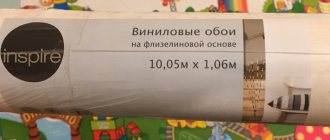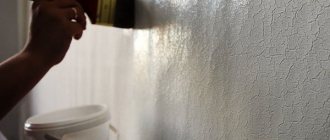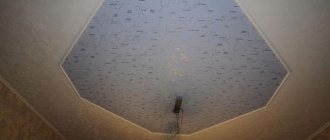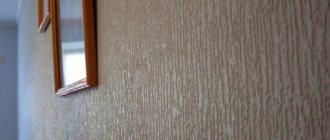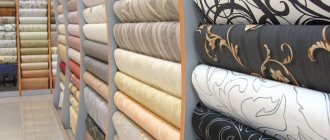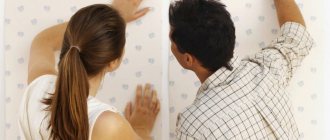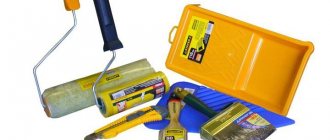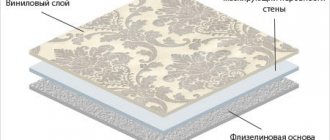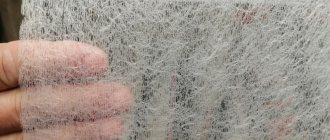When renovation work is underway, the timing of completion of the various stages is important. After all, this determines how long it will take to move on to a new part of the work. Spending too much time on repairs is not always possible and impractical; knowing how to reduce the time for certain stages will make the process easier. How long it takes non-woven wallpaper to dry after gluing will be discussed further; options for shortening this process will also be considered.
Indoor microclimate
To obtain a good result when wallpapering, a suitable microclimate must be created in the building. Optimal temperatures range from +15 to +24 degrees.
In hotter room conditions, the adhesive solution will dry quickly and will need to be reapplied.
The humidity in the house should be at least 50%, preferably 60%. If you decide to hang wallpaper in the summer, then to improve the humidity level, you can spray water with a sprinkler. On the side where the sun is shining, it is worth covering the access to the sun's rays with thick curtains, this will reduce the heat.
Windows and doors are left closed during this period.
Optimal temperatures range from +15 to +24 degrees.
Factors affecting drying speed
There are a number of factors that influence the time required for wallpaper to dry. Knowing them will help optimize conditions. These include:
- It is important what material the base on which the wallpaper will be glued is made of. After all, different surfaces absorb moisture differently. Drywall absorbs moisture better than a brick wall, so the glue will dry faster on the gypsum board. Also, the drying time depends on the type of glue;
- Humidity indicators. With high humidity, drying will naturally take longer. A microclimate that is too dry will speed up the process, which will lead to poor adhesion; more adhesive solution will have to be applied;
- The temperature in the room affects the timing; the lowest temperature for work is +7 degrees. It is necessary to ensure that there are no drafts in the room, that the temperature does not change, and that heaters cannot be used for drying. Such actions will lead to partial or complete peeling of the material.
Changing the temperature while the wallpaper is drying can lead to it peeling off.
It is permissible to open windows after the glue has completely hardened.
With high humidity, drying will naturally take longer.
Preparing the walls
To create a high-quality and beautiful interior, smooth walls are desirable, at least without serious flaws. How to achieve this? Of course, plaster or putty some places on the wall.
In the vast majority of standard domestic apartments, it is impossible to do without such work, so we strongly recommend studying the geometry of your walls.
After plastering work, it is necessary to give the solution time to dry. The drying process goes well at a comfortable room temperature of 20 degrees and a minimum humidity tending to 100%, or at least 80%. Otherwise, hardening of the plaster may be delayed indefinitely.
Related article: Just look at what unusual designs can be made using glass hemispheres
This is what a well prepared wall looks like
The next best step to prepare the wall surface for wallpapering is to prime it. Priming is done with special compounds or with the same wallpaper glue that is subsequently used to glue wallpaper, only diluted in more water.
The method of priming walls with wallpaper glue is described in detail on its pack.
The primer helps the wall adapt to the upcoming gluing, let's call it that. In addition, it greatly reduces the consumption of wallpaper glue itself. As you probably already guessed, you again need to wait for the wall surface to dry, but this time it will happen much faster. The guideline for drying the primer is 5-6 hours.
A good composition for preparing walls for wallpapering
Now you and the walls are really ready for wallpapering, and it’s time to start the main work. But first, we would like to talk about the negative consequences of sticking to a damp wall.
- Peeling - Because the wall and wallpaper are wet, they are not ready to adhere to each other. The wallpaper comes off the wall easily.
- Deformation is the stretching and narrowing of wallpaper on the wall, while the piece does not have an exact position and is able to move.
- Divergence of joints - the consequence of deformation will be the divergence of seams, which at a minimum will attract attention, and at maximum will ruin the entire repair.
It’s unpleasant and offensive, and all these problems are just because of a damp wall. Vinyl wallpaper takes an infinitely long time to dry on such a surface, during which time the result of the work can deteriorate even further. In addition, long drying delays other repair work: installation of the ceiling, baseboard.
Current relevance of the rule
When it comes to paper types of wallpaper, the rule of keeping windows and doors closed still holds true. To obtain the desired quality result, you need to follow a number of rules:
- During pasting and after its completion, you need to wait 2 days until the windows in the room can be opened. Paper webs dry after half a day if the temperature is +20 degrees. But it’s better to wait 2 days, because ensuring that the necessary conditions for drying are met is problematic;
- Turning on the air conditioner during this process is undesirable; when the moisture evaporates, the room will become stuffy;
- The use of a fan should also be avoided; it will disrupt the temperature regime and the readings will be unevenly distributed. Heating devices should not be used either.
To understand whether the coating has dried, touch the wallpaper with your hands; if it is dry, you should wait a little longer. If they are wet, wait for them to dry, and just in case, wait a couple of hours after that.
During pasting and after its completion, you need to wait 2 days until the windows in the room can be opened.
How quickly different types of wallpaper dry
The time required to dry wallpaper depends on the base from which it is made. You can find various types of these products on sale, so it is advisable to ask the store about these terms.
The time required to dry wallpaper depends on the base from which it is made.
Non-woven
The instructions for gluing non-woven fabrics indicate that it takes at least 24 hours to fix them to the surface. It is prohibited to engage in other finishing work or open windows during this period. The indicated period is correct if standard conditions are met (+15 degrees and humidity 60%), in other microclimatic conditions the time increases.
The instructions for gluing non-woven fabrics indicate that it takes at least 24 hours to fix them to the surface.
Vinyl
How long it takes for wallpaper to dry after hanging vinyl depends on its base. Non-woven base, it will take from 24 to 48 hours, with high humidity the time is doubled. You should not open the windows if the work was carried out in winter or late autumn, when the climatic conditions are cold, it is optimal to wait seven days. The paper backing of vinyl wallpaper requires 18-24 hours to dry.
How long it takes for wallpaper to dry after hanging vinyl depends on its base.
Paper
The time needed to dry paper sheets is influenced by several factors: the quality of preparation of the base, whether a primer solution was used, whether the technology for preparing wallpaper glue was followed. If these conditions are met, then canvases with a top layer of non-woven fabric will dry in two to three days, vinyl ones will dry in 24 hours, and ordinary paper sheets will dry in half a day.
Canvases with a top layer of non-woven fabric will dry in two to three days, those made of vinyl will dry in 24 hours, and regular paper sheets will dry in half a day.
Liquid
Manufacturers indicate drying times on the packaging of liquid wallpaper, but they are relevant under ideal conditions. Therefore, they often differ from the indicators of people carrying out repairs. Testing for drying involves touching the surface with your hand; if the material does not stick, this indicates that the canvas has dried out. However, such a check may leave flaws in the coating, so it should not be abused.
If the room temperature is +15 degrees or more, and the humidity is not too low, the approximate drying time will be 24 hours. This process is also affected by the base material. Drying wallpaper on a gypsum base takes less time than on a concrete base.
If the room temperature is +15 degrees or more, and the humidity is not too low, the approximate drying time will be 24 hours.
What you should definitely pay attention to
The first thing to consider is the labeling of the wallpaper. Each roll has a label. It contains icons, or pictograms, that have their own designation, for example:
- Icon with a tassel and a vertical stripe. This indicates that the canvas is not saturated with glue. You just need to apply it to the walls.
- Brush icon and horizontal stripe. This means that they need to be pre-impregnated with glue.
- Shown is a container with a roll. These wallpapers already have glue. It is applied at the manufacturer's factory. During repairs, the canvas is simply moistened with water.
You need to purchase the glue that will match the purchased type of wallpaper.
Why you can’t open windows and doors after finishing work
Compliance with this rule is required so that the adhesive solution does not dry out too quickly. Such acceleration will cause the canvases to move away from the surface and may completely fall.
Paper and non-woven coverings tolerate drafts and temperature changes the worst. Vinyl wallpapers are less picky, but they can also come off the base and their appearance will deteriorate.
Compliance with this rule is required so that the adhesive solution does not dry out too quickly.
Interior transformation: learning how to glue non-woven wallpaper
Reading time: 7 minutes No time?
We will send the material to you by e-mail
When choosing a finishing material for walls, many people opt for non-woven wallpaper, and it’s clear why. This type of coating can well disguise many surface defects, simply hiding them and making the walls decorative in one day. The editors of HomeMyHome will tell you how to glue non-woven wallpaper according to all the rules of experienced craftsmen.
Beautiful and durable canvases for a chic interior look PHOTO: remontonly.ru
How to choose a material and calculate its quantity: don’t make mistakes
The whole selection process consists of finding suitable wallpaper and the glue needed for it.
Non-woven wallpaper: what are they?
There are two types of wallpaper based on non-woven fabric:
- the canvas is entirely made of non-woven fabric;
- interlining and vinyl.
You can choose the color and texture to suit any taste PHOTO: homeli.ru
Excellent choice of finishing materials PHOTO: roomester.ru
How to speed up the process
It is not recommended to speed up this stage using professional technology, and this applies to all types of canvases. But, when the work was deliberately carried out in violation, then you need to be prepared for the appearance of defects during gluing. In some cases, this is justified by circumstances that do not allow for a long wait.
It is not recommended to speed up this stage using professional technology, and this applies to all types of canvases.
Why does wallpaper peel off walls after hanging?
Decorating a room with wallpaper is the final stage of renovation. At first glance, the procedure gives the impression of a simple job, but if the rules and features of the process are not followed, the new coating does not adhere well to the base. After hanging, the wallpaper peels off the walls for several reasons.
- The surface is poorly prepared
- Technology violations were committed
- Manufacturer's recommendations were ignored
- Low-quality building materials used
- The glue is poorly distributed
- The glue drying process is disrupted
The surface is poorly prepared
In order for the wallpaper to stick securely, the base must be carefully prepared. To do this, fill voids in the walls, fill cracks, remove areas of weak plaster, old paint and whitewash. Then level the surface and coat with primer.
How to reduce humidity
Drafts should not be allowed, so it is better to use a dehumidifier; this device will remove excess moisture and reduce drying time. It is usually used if several layers of plaster mortar were applied, or liquid types of flooring were used. It is better to start it before the gluing process, and after gluing is completed, turn on the device again.
You should not reduce the humidity too much; it is advisable to bring it to 50-60%.
Drafts should not be allowed, so it is better to use a dehumidifier; this device will remove excess moisture and reduce drying time.
How to raise the temperature so as not to spoil the canvas
When the room was not heated before the renovation, and the temperature readings are too low for the drying process, it is necessary to warm up the room. Before gluing, any types of heaters can be used, but when gluing is carried out and after it, the use of “heat guns” and converter-type devices is excluded. It is necessary to use a heater that provides constant heat without creating air currents. For example, an oil heater.
It is important to maintain the temperature at the same level, avoiding fluctuations.
It is necessary to use a heater that provides constant heat without creating air currents.
Is it possible to turn on the fan?
During operation, the fan distributes air into different zones, so the temperature in different parts of the room where the renovation was carried out will be non-uniform. In turn, the glue does not dry solidly, so as a result, the wallpaper may peel off in places, or some of the canvases will fall off entirely. You will need to re-glue these areas, or re-glue the entire strips.
During operation, the fan distributes air into different zones, so the temperature in different parts of the room where the renovation was carried out will be non-uniform.
The stage of drying the wallpaper is an important part of the repair; therefore, it is advisable to follow the rules of this stage. If you take your time and create optimal conditions for the canvases to dry, then gluing them to the surface will proceed without defects, and you won’t have to glue them twice. When determining the required deadlines, pay attention to the type of base and the type of wallpaper itself. As a result, you can get high-quality wallpaper that will perfectly complement the design of the room.
How long does vinyl wallpaper last?
Before pasting, sealed rolls of wallpaper
must
be kept
in the room where repairs will be carried out for 2 days. Make sure that the Batch number matches on all rolls, check the appearance of the rolls.
Interesting materials:
How to say thank you to your friends for their congratulations? How to say thank you to a friend? How is the word night pronounced? How to inflect the word day? How to copy an Sbis electronic signature? How to hide cell contents in Excel? How to hide an incoming call on iPhone? How does the skin peel off after scarlet fever? How to listen to music on PS4 from iPhone? How to listen to music in DS?
